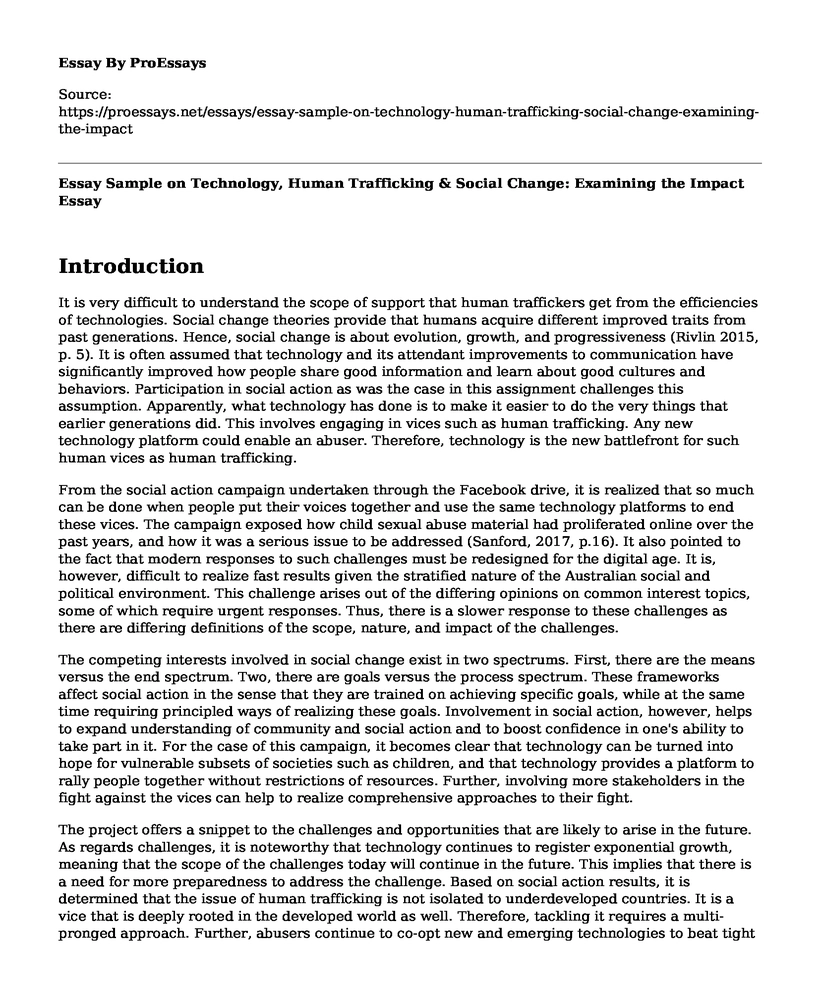Introduction
It is very difficult to understand the scope of support that human traffickers get from the efficiencies of technologies. Social change theories provide that humans acquire different improved traits from past generations. Hence, social change is about evolution, growth, and progressiveness (Rivlin 2015, p. 5). It is often assumed that technology and its attendant improvements to communication have significantly improved how people share good information and learn about good cultures and behaviors. Participation in social action as was the case in this assignment challenges this assumption. Apparently, what technology has done is to make it easier to do the very things that earlier generations did. This involves engaging in vices such as human trafficking. Any new technology platform could enable an abuser. Therefore, technology is the new battlefront for such human vices as human trafficking.
From the social action campaign undertaken through the Facebook drive, it is realized that so much can be done when people put their voices together and use the same technology platforms to end these vices. The campaign exposed how child sexual abuse material had proliferated online over the past years, and how it was a serious issue to be addressed (Sanford, 2017, p.16). It also pointed to the fact that modern responses to such challenges must be redesigned for the digital age. It is, however, difficult to realize fast results given the stratified nature of the Australian social and political environment. This challenge arises out of the differing opinions on common interest topics, some of which require urgent responses. Thus, there is a slower response to these challenges as there are differing definitions of the scope, nature, and impact of the challenges.
The competing interests involved in social change exist in two spectrums. First, there are the means versus the end spectrum. Two, there are goals versus the process spectrum. These frameworks affect social action in the sense that they are trained on achieving specific goals, while at the same time requiring principled ways of realizing these goals. Involvement in social action, however, helps to expand understanding of community and social action and to boost confidence in one's ability to take part in it. For the case of this campaign, it becomes clear that technology can be turned into hope for vulnerable subsets of societies such as children, and that technology provides a platform to rally people together without restrictions of resources. Further, involving more stakeholders in the fight against the vices can help to realize comprehensive approaches to their fight.
The project offers a snippet to the challenges and opportunities that are likely to arise in the future. As regards challenges, it is noteworthy that technology continues to register exponential growth, meaning that the scope of the challenges today will continue in the future. This implies that there is a need for more preparedness to address the challenge. Based on social action results, it is determined that the issue of human trafficking is not isolated to underdeveloped countries. It is a vice that is deeply rooted in the developed world as well. Therefore, tackling it requires a multi-pronged approach. Further, abusers continue to co-opt new and emerging technologies to beat tight regulations (Thorn.org 2019). Considering the slow pace and the lack of common front against human trafficking, it is likely that all social actions will continue to be reactionary. As regards opportunities, it is noteworthy that every technology can be used to counteract the vices.
Conclusion
There is a close link between global and local skills as regards these campaigns. As has been noted, these challenges are not isolated to one part of the globe (Thorn.org 2019). Hence, there is a need for a concerted effort. There is also a need for a common understanding of the scope and impact of the problem. One thing that technology has been able to do is to unite the world so that information can be transmitted fast between two remote locations. Social change, as has been determined, results in demographic processes. Advancements do not favor all points equally. Therefore, there is a need for proper regulation to ensure a balance and that the less advanced are not manipulated. Social action helps to realize this.
References
Rivlin, A. M. (2015). Systematic thinking for social action. Brookings Institution Press.
Sanford, N. (2017). Self and society: Social change and individual development. Routledge.
Thorn.org. (2019). We Build Tools to Defend Children From Sexual Abuse | Thorn. Retrieved 24 November 2019, from https://www.thorn.org/
Cite this page
Essay Sample on Technology, Human Trafficking & Social Change: Examining the Impact. (2023, Mar 04). Retrieved from https://proessays.net/essays/essay-sample-on-technology-human-trafficking-social-change-examining-the-impact
If you are the original author of this essay and no longer wish to have it published on the ProEssays website, please click below to request its removal:
- Research Paper on How People Understand Feminism in the Society
- Essay Sample on Concept Mapping of Bullying
- Essay Sample on Workplace Violence and Harassment Prevention Program
- Life Events & Substance Use: Annotated Bibliography
- Essay Sample on Immigrants: Impacting the US Economy in Small and Large Scale Businesses
- Essay Example on Online Addiction: Gaming Disorder Affecting Social Relationships
- Terrorism's Impact on Nigeria: Boko Haram and Beyond - Essay Sample







